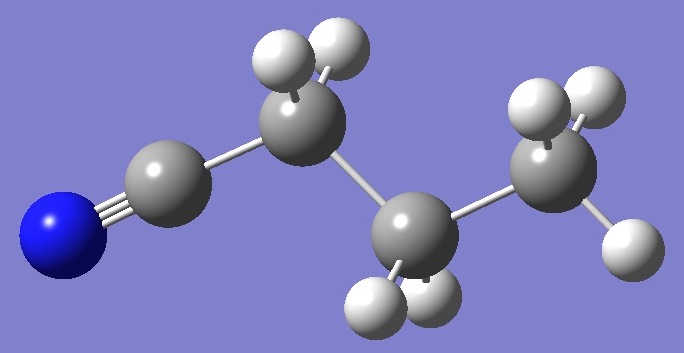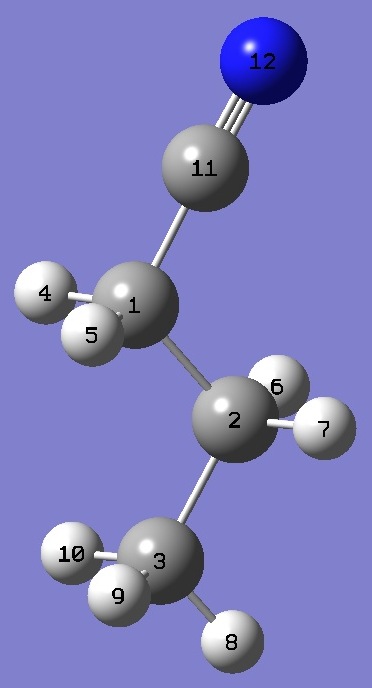|
|
|
|
|
|
|
|
|
|
|
|
|
|
|
|
|
|
|
|
|
CH3CH2CH2CN
|

|
|
|
|
|
|
|
|
|
|
|
|
|
|
|
|
|
|
|
|
|
|
|
|
|
|
|
|
|
|
|
|
|
|
|
Nitrogen
|
|
|
Nuclear
Quadrupole Coupling Constants |
|
|
|
in
t-1-Cyanopropane |
|
|
|
|
|
|
|
|
|
|
|
|
|
|
|
|
|
|
|
|
|
|
|
|
|
|
|
|
|
|
|
|
|
Calculation of the nitrogen nqcc
tensor in the trans conformer
of 1-cyanopropane (aka trans
butyronitrile) was made here on an approximate equilibrium
molecular structure given by MP2/aug-cc-pVTZ
optimization with empirically corrected equilibrium bond lengths.
These are
compared in Table 1 with the experimental nqcc's of Demaison and
Dreizler [1].
Structure parameters are given in Table 2, rotational constants
in Table 3, dipole moments and quartic centrifugal distortion constants in Table 4.
|
|
|
|
|
|
|
|
|
|
|
|
|
In Table 1, subscripts a,b,c refer to
the principal axes of the inertia tensor, subscripts x,y,z to the
principal axes of the nqcc tensor. The nqcc y-axis is chosen
coincident with the inertia c-axis, these are perpendicular to the Cs
plane of the molecule. Ø (degrees) is the angle between
its subscripted parameters. ETA = (Xxx - Xyy)/Xzz. |
|
|
RMS is the root mean square
difference between calculated and experimental nqcc's (percentage of
average experimental nqcc). RSD is the residual standard
deviation
of calibration of the B3PW91/6-311+G(df,pd) model for calculation of
the nqcc's. |
|
|
|
|
|
|
|
|
|
|
|
|
|
|
|
|
|
|
|
|
|
|
| |
|
|
|
|
|
|
|
|
Table 1.
Nitrogen nqcc's in t-1-Cyanopropane
(MHz). |
|
| |
|
|
|
|
|
|
|
|
|
|
|
Calc. |
|
Expt. [1] |
|
| |
|
|
|
|
|
|
|
|
14N |
Xaa |
- |
3.426 |
- |
3.405(45) |
|
|
|
Xbb |
|
1.358 |
|
1.341(50) |
|
|
|
Xcc |
|
2.068 |
|
2.064(39) |
|
|
|
|Xab| |
|
2.090 |
|
2.090(32) * |
|
|
|
|
|
|
|
|
|
|
|
RMS |
|
0.016 (0.71 %) |
|
|
|
|
|
RSD |
|
0.030 (1.3 %) |
|
|
|
|
|
|
|
|
|
|
|
|
|
Xxx |
|
2.143 |
|
2.130(48) ** |
|
|
|
Xyy |
|
2.068 |
|
2.064(39) |
|
|
|
Xzz |
- |
4.211 |
- |
4.194(44) |
|
|
|
ETA |
- |
0.018 |
- |
0.015(15) |
|
|
|
Øz,a |
|
20.57 |
|
20.68(29) |
|
|
|
Øa,CN |
|
20.93 |
|
|
|
|
|
Øz,CN |
|
0.36 |
|
|
|
|
|
|
|
|
|
|
|
|
|
| |
|
|
|
|
|
|
|
|
|
|
* Calculated value, with an estimated
uncertainity of 2*RMS. |
|
|
** Calculated here using Kisiel's QDIAG.f
program. |
|
|
|
|
|
|
|
|
|
|
|
|
|
|
|
|
| Table 2. t-1-Cyanopropane. Heavy atom molecular
structure parameters (Å and degrees). Complete structure is
given here in Z-matrix
format. |
| |
|
|
|
|

|
C(11)N |
1.1561 |
|
C(1)C(11) |
1.4600 |
|
C(1)C(11)N |
178.39 |
|
|
|
|
C(1)C(2) |
1.5285 |
|
C(2)C(3) |
1.5198 |
|
C(11)C(1)C(2) |
112.03 |
|
C(1)C(2)C(3) |
110.95 |
|
|
|
|
|
|
|
|
|
|
|
|
|
|
|
|
|
|
|
| |
|
|
|
| Table 3.
t-1-Cyanopropane.
Rotational Constants (MHz). |
|
|
|
|
|
|
Calc. ropt |
Expt. [2]
|
|
|
|
|
|
A |
23 868.9 |
23668.31931(143)
|
|
B |
2 289.9 |
2268.146892(147)
|
|
C |
2 173.3 |
2152.963946(168)
|
|
|
|
|
|
|
|
|
|
|
|
|
|
|
|
|
|
|
|
|
|
|
|
| |
|
|
|
|
|
Table 4.
t-1-Cyanopropane. Dipole Moments [3] and Quartic Centrifugal Distortion Constants [2]. Calc = B3LYP/cc-pVTZ.
|
|
|
|
|
|
|
|
|
|
Calc.
|
|
Expt. [2,3]
|
|
|
|
|
|
|
|
|µa| /D
|
|
4.04
|
|
3.597(59)
|
|
|µb| /D
|
|
1.07
|
|
0.984(15)
|
|
|
|
|
|
|
|
DJ /kHz
|
|
0.380
|
|
0.398674(69)
|
|
DJK /kHz |
-
|
10.3
|
-
|
10.82631(92)
|
|
DK /kHz |
|
237.
|
|
240.653(29)
|
|
d1 /Hz |
-
|
43.3
|
-
|
46.637(42)
|
|
d2 /Hz |
-
|
0.473
|
-
|
0.5901(59)
|
|
|
|
|
|
|
|
|
|
|
|
|
|
|
|
|
|
|
|
|
|
|
|
|
|
|
|
|
|
[1] J.Demaison and H.Dreizler,
Z.Naturforsch. 37a,199(1982). |
|
|
[2] G.Wlodarczak, L.Martinache, J.Demaison, K.-M.Marstokk, and H.Møllendal, J.Mol.Spectrosc. 127,178(1988).
|
|
|
[3] A.Belloche, R.T.Garrod, H.S.P.Müller, K.M.Menten, C.Comito, and P.Schilke, A & A 499,215(2009).
|
|
|
|
|
|
|
|
|
|
|
|
|
K.Vormann and H.Dreizler,
Z.Naturforsch. 43a,338(1988): Xaa = -3.440(4)
MHz, Xbb = 1.385(5) MHz, Xcc
= 2.056(5) MHz.
|
|
|
|
|
|
|
|
|
|
|
|
|
|
|
|
|
|
|
|
|
|
|
n-Butyl
Cyanide, anti-anti |
1-Cyanopropane,
gauche |
|
|
n-Butyl Cyanide, anti-gauche |
CH3CN |
|
|
|
n-Butyl
Cyanide, gauche-anti |
CH3CH2CN |
|
|
|
|
|
|
|
|
|
|
|
|
|
|
|
|
|
|
|
|
|
|
Table of Contents |
|
|
|
|
|
Molecules/Nitrogen |
|
|
|
|
|
|
|
|
|
|
|
|
|
|
|
|
|
|
|
|
|
|
|
|
|
|
|
|
|
|
t1CNpropane.html |
|
|
|
|
|
|
Last
Modified 23 Aug 2010 |
|
|
|
|
|
|
|
|
|
|

